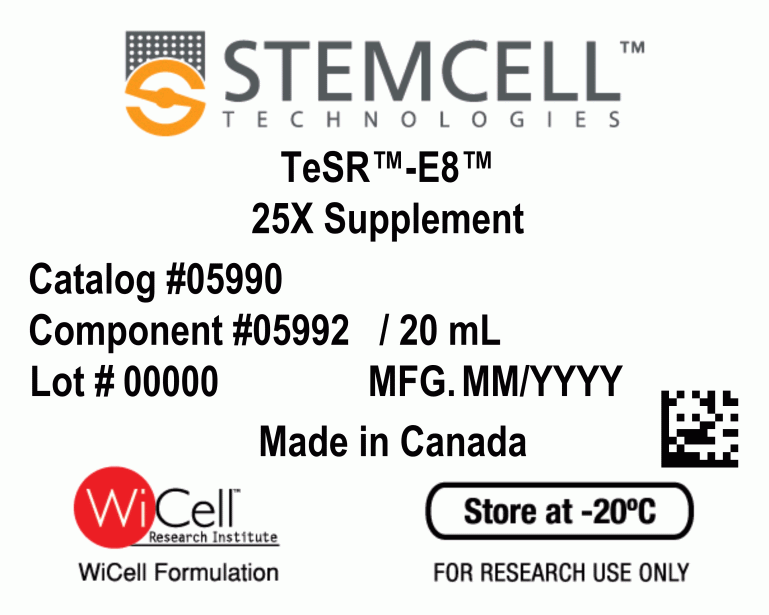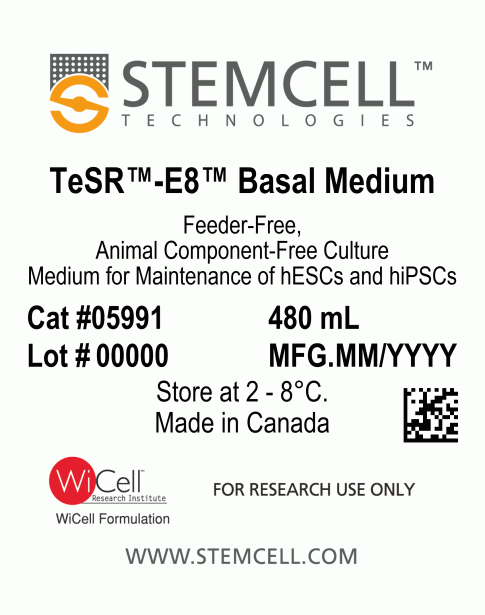TeSR™-E8™
Feeder-free, animal component-free culture medium for maintenance of human ES and iPS cells
概要
TeSR™-E8™ is a feeder-free, animal component-free culture medium for human embryonic stem (ES) cells and human induced pluripotent stem (iPS) cells. It is based on the E8 formulation developed by the laboratory of Dr. James Thomson (University of Wisconsin-Madison), the lead research group behind the design of mTeSR™1, the most widely published feeder-free culture medium for pluripotent stem cells.
Like mTeSR™1, TeSR™-E8™ medium is made with the highest level of quality and care. It contains only the essential components required for maintenance of ES and iPS cells, providing a simpler medium for the culture of pluripotent stem cells. TeSR™-E8™ may be used with either Corning® Matrigel® hESC-Qualified Matrix (Catalog #07181) or, for a completely defined xeno-free system, Vitronectin XF™ (Catalog #07180, a matrix developed and manufactured by Nucleus Biologics) as the culture matrix.
Like mTeSR™1, TeSR™-E8™ medium is made with the highest level of quality and care. It contains only the essential components required for maintenance of ES and iPS cells, providing a simpler medium for the culture of pluripotent stem cells. TeSR™-E8™ may be used with either Corning® Matrigel® hESC-Qualified Matrix (Catalog #07181) or, for a completely defined xeno-free system, Vitronectin XF™ (Catalog #07180, a matrix developed and manufactured by Nucleus Biologics) as the culture matrix.
Advantages
• Simplified, low-protein formulation based on the popular mTeSR™1 medium for maintaining human ES and iPS cells
Components
- TeSR™-E8™ Basal Medium, 480 mL
- TeSR™-E8™ 25X Supplement, 20 mL
Subtype
Specialized Media
Cell Type
Pluripotent Stem Cells
Species
Human
Application
Cell Culture, Expansion, Maintenance
Brand
TeSR
Area of Interest
Stem Cell Biology
Formulation
Serum-Free
技术资料
| Document Type | 产品名称 | Catalog # | Lot # | 语言 |
|---|---|---|---|---|
| Product Information Sheet | TeSR™-E8™ Kit for hESC/hiPSC Maintenance | 05990 | All | English |
| Manual | TeSR™-E8™ | 05990 | All | English |
| Safety Data Sheet 1 | TeSR™-E8™ Kit for hESC/hiPSC Maintenance | 05990 | All | English |
| Safety Data Sheet 2 | TeSR™-E8™ Kit for hESC/hiPSC Maintenance | 05990 | All | English |
数据及文献
Publications (4)
Biosensors 2019 apr
A Novel Toolkit for Characterizing the Mechanical and Electrical Properties of Engineered Neural Tissues.
Abstract
Abstract
We have designed and validated a set of robust and non-toxic protocols for directly evaluating the properties of engineered neural tissue. These protocols characterize the mechanical properties of engineered neural tissues and measure their electrophysical activity. The protocols obtain elastic moduli of very soft fibrin hydrogel scaffolds and voltage readings from motor neuron cultures. Neurons require soft substrates to differentiate and mature, however measuring the elastic moduli of soft substrates remains difficult to accurately measure using standard protocols such as atomic force microscopy or shear rheology. Here we validate a direct method for acquiring elastic modulus of fibrin using a modified Hertz model for thin films. In this method, spherical indenters are positioned on top of the fibrin samples, generating an indentation depth that is then correlated with elastic modulus. Neurons function by transmitting electrical signals to one another and being able to assess the development of electrical signaling serves is an important verification step when engineering neural tissues. We then validated a protocol wherein the electrical activity of motor neural cultures is measured directly by a voltage sensitive dye and a microplate reader without causing damage to the cells. These protocols provide a non-destructive method for characterizing the mechanical and electrical properties of living spinal cord tissues using novel biosensing methods.
Cell stem cell 2017 MAR
Comprehensive Cell Surface Protein Profiling Identifies Specific Markers of Human Naive and Primed Pluripotent States.
Abstract
Abstract
Human pluripotent stem cells (PSCs) exist in naive and primed states and provide important models to investigate the earliest stages of human development. Naive cells can be obtained through primed-to-naive resetting, but there are no reliable methods to prospectively isolate unmodified naive cells during this process. Here we report comprehensive profiling of cell surface proteins by flow cytometry in naive and primed human PSCs. Several naive-specific, but not primed-specific, proteins were also expressed by pluripotent cells in the human preimplantation embryo. The upregulation of naive-specific cell surface proteins during primed-to-naive resetting enabled the isolation and characterization of live naive cells and intermediate cell populations. This analysis revealed distinct transcriptional and X chromosome inactivation changes associated with the early and late stages of naive cell formation. Thus, identification of state-specific proteins provides a robust set of molecular markers to define the human PSC state and allows new insights into the molecular events leading to naive cell resetting.
Stem cell research 2017
Generation of non-transgenic iPS cells from human cord blood CD34+ cells under animal component-free conditions.
Abstract
Abstract
Recently, many hurdles and limitations for production of clinically applicable iPSC derivatives have been overcome. Transgene-free iPSCs can be efficiently derived from easily accessible cell sources such as blood. Here we describe the generation of transgene-free hiPS cells from cord blood derived CD34+ cells, reprogrammed using CytoTune™ Sendai reprogramming vectors. CD34+ cell isolation, cultivation, reprogramming and establishment of resulting hiPSC lines were performed under the exclusive usage of animal-derived component-free (ADCF) materials and components.
Stem cell research 2017
Peripheral blood derived induced pluripotent stem cells (iPSCs) from a female with familial hypertrophic cardiomyopathy.
Abstract
Abstract
Induced pluripotent stem cells (iPSCs) were generated from peripheral blood mononuclear cells (PBMCs) obtained from a 62-year-old female with familial hypertrophic cardiomyopathy (HCM). PBMCs were reprogrammed to a pluripotent state following transfection with non-integrative episomal vectors carrying reprogramming factors OCT4, SOX2, LIN28, KLF4 and L-MYC. iPSCs were shown to express pluripotency markers, possess trilineage differentiation potential, carry rare variants identified in DNA isolated directly from the patient's whole blood, have a normal karyotype and no longer carry episomal vectors for reprogramming. This line is a useful resource for identifying unknown genetic causes of HCM.



